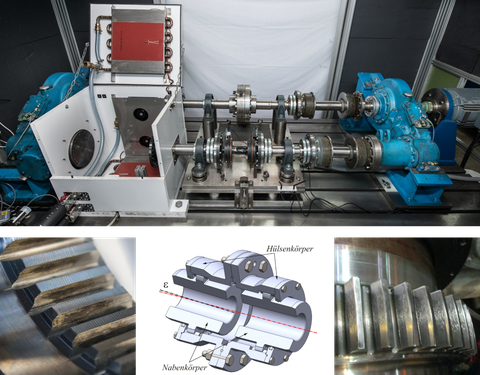ZakuFress
Method for determining the scuffing load capacity of displaceable tappet toothing in gear couplings
| Funding: |
AiF – German Federation of Industrial Research Associations FVA – Research Association for Drive Technology |
| Funding code: |
FVA number and key word: FVA 613 II scuffing load capacity gear coupling | AiF number: 19199 BR |
| Partner: |
Flender GmbH KWD Kupplungswerk Dresden GmbH |
| Duration: | 04/2017 - 04/2020 |
| Contact: | Thomas Breitenbach |
As a widespread machine element for positive power transmission with very good synchronization properties and high power density at the same time, the curved tooth coupling can be found particularly in rail drives, the steel and metal industry, conveyor systems in the mining and mining sector and in power plants. Due to the characteristic curved tooth shape and the spherical outer teeth, the hub allows angular displacement relative to the straight-toothed sleeve. In a double gimbal arrangement, radial, axial and angular shaft misalignment can be compensated. In the case of angular or radial misalignments, the hub performs a characteristic tilting and swiveling movement with respect to the sleeve, as a result of which the tooth flanks in contact make sliding against one another at periodically fluctuating speeds.
The losses occurring in the frictional contact of the relatively moving tooth flanks in combination with high flank pressures often lead to signs of wear which, if the permissible material or lubricant limits are exceeded, lead to failure of the machine element. Seizing as a result of thermal overloads and excessive pressures on the tooth flank surfaces is a particularly common occurrence of damage. Due to the temperature-dependent change in viscosity, the increasing heating of material and lubricant reduces the effective lubricant film thickness. If the lubricating oil film breaks off or is locally broken, the metallic surfaces can weld locally. As a result of the relative movement, the welding points outside the original material separation plane are torn apart again. Striped roughening occurs in the tooth width direction on the tooth flanks. These in turn promote adhesive wear in tooth contact up to the spontaneous failure of the connecting element.
Although the driver teeth in gear couplings also have the characteristic involute profile of the typical spur gear teeth, due to a different engagement behaviour, the methodical approach to determining the seizure resistance in running gear teeth cannot be transferred without restriction to displaceable driver teeth. In this research project, it is therefore important to quantify the specific frictional powers that occur in tooth contact under the given operating parameters and to describe the resulting thermal conditions. Taking into account the subsequent heat transfer processes, the maximum permissible contact temperature at which there is just no seizing is to be determined. In a further step, typical design criteria are to be derived from this in order to improve the prognosis of adhesive wear and prevent operational failures.



